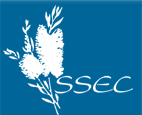
|
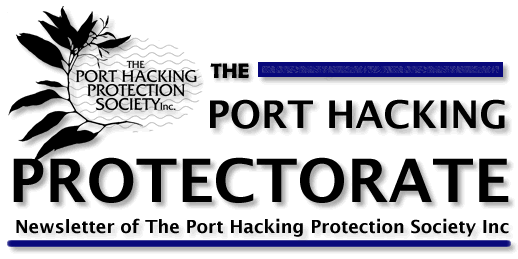 |
May 1995 |
|
 |
Editorial
Issue No. 8 of the Port Hacking Protectorate is the second in a series of newsletters sponsored by the Hacking River Catchment Management Committee to increase the awareness of residents and users of Port Hacking on issues regarding the Waterway.
In this Newsletter we are particularly concerned to highlight those issues to do with the water quality of Port Hacking. The Hacking River Catchment Management Committee has once again provided the newsletter with a lead article on its work in preparing a database of studies on water quality or aspects of water quality in the catchment. Findings from the study are interesting. It is equally interesting to note that the information is scattered and some of it of doubtful validity. The work that the Hacking River Catchment Management Committee has embarked on and plans to continue with respect to updating the database is important. |
| Without accurate knowledge of water quality and how it is affected, it is impossible to make sound decisions about where community efforts and scarce public dollars are best targetted to maintain a pristine waterway. |
|
An important actor, and an active one with respect to safeguarding the quality of Port Hacking's water, is Sutherland Shire Council. The Council has undertaken many initiatives, together with other authorities, to arrest major sources of pollution into the Port Hacking. These initiatives range from constructing gross pollutant traps and artificial wetlands, to public information efforts. A discussion of these initiatives by Council will be a feature of the next issue of the Protectorate.
A concern when issues of water quality are raised is the management of our sewerage systems. An underlying theme of Sydney Water's item in the last issue of the Protectorate (No.7) was how the authority is attempting to minimise pollutants escaping into waterways. In this issue of the Protectorate, the continuing discussion on wastewater management is explored in more detail. |
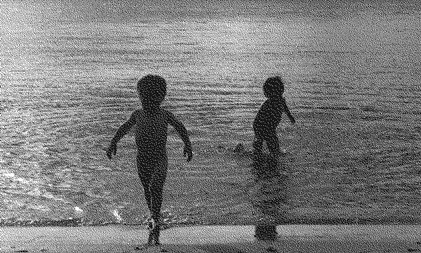 |
We invite you to write to us with issues about Port Hacking you would like to have aired. In the next issue of the Protectorate, we will be examining the very thorny problem of landbased development - such as medium density housing and foreshore codes.
Water, Water Everywhere |
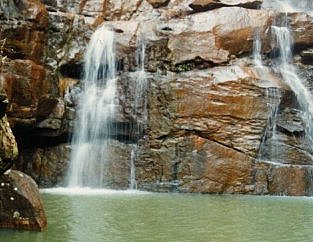 |
In an effort to discover what is known about the waterway's water quality, the Hacking River Catchment Management Committee engaged the services of an expert researcher, Ms. Heidi Fenech, to put together a database of all studies dealing with or partially dealing with water quality.
Ms. Fenech identified 163 studies. Of these:
-
79 were water quality and water chemistry studies - 24 reported good water quality in the Hacking River catchment, 39 reported varying degrees of poor water quality and 16 did not interpret results but merely recorded findings
-
37 studies focussed on aquatic fauna, attempting to correlate species richness and diversity with water quality
-
47 studies are miscellaneous but contain relevant data about the condition of the catchment
Taken together, the studies show that the Hacking River catchment is impacted by both point and non-point pollutant sources. An example of a point pollutant source is a sewage pumping station overflow, while an example of a non-point pollutant source is a series of seeping septic systems.
The tributaries of the Hacking River which were identified as having poor water quality were Gills Creek, Gardiners Creek, Camp Creek and Tip Creek. Bola Creek was described frequently as being 'almost pristine'.
Although water quality in the upper Hacking River is relatively poor it does improve downstream (possibly related to the greater dilution factor rather than fewer pollution sources).
Coonong Creek has good water quality in dry weather and poorer water quality in wet weather due to sewer overflows. However, when sewer overflows occur in dry weather the effluent has a 'toxic' effect on the water.
Water quality at Gills Creek was reported as being generally poorer than at other urban sites in the Hacking River. Once again this may be due to the ability of larger volumes of water in the Hacking River to assimilate pollutants.
Heavy metal concentrations in Port Hacking and the Hacking River are lower than other urban catchments, such as the George's River, probably because of residential rather than industrial foreshore occupation.
Since the commissioning of the deepwater ocean outfalls there has been no real effect on water quality in Bate Bay. Faecal coliform levels have remained unchanged. The pollution that does occur along the beaches of Bate Bay is local in origin and is probably from the Cronulla Sewage Treatment Plant discharge at Potter Point. Stormwater entering Bate Bay beaches is of poor quality after periods of intense rain, contributing greatly to the degradation of the water quality on Bate Bay beaches. The deepwater ocean outfalls have had similarly no discernible effect on water quality at Garie Beach.
Although the data from the studies give a good indication of water quality results over time, water quality can only be determined by sampling undertaken today. Seventy one of the studies (43%) were undertaken before 1990 and a number of the studies which provide information about the Hacking Catchment use questionable techniques or methods for gathering data. Both these factors indicate a need for ongoing and thorough monitoring of the waterway to provide an accurate basis for deciding upon appropriate action to safeguard its nature.
To have a detailed database of levels of water quality in the Hacking catchment area is one thing. To do something about it is another. The HRCMC is determined that initiatives must be developed to improve water quality. Already several known (and unacceptable) sources of pollution have been isolated for attention. Offending sites exist in both the Upper Hacking River zone as well as surrounding the Port itself. It is envisaged that these issues will be addressed at the HRCMC's Strategic Plan Workshop, being held on Sunday 28 May.
What the studies identified as the main environmental problems in the Hacking River Catchment.
Siltation/Sedimentation: Marine sand shoaling was referred to by a number of studies as a navigational hazard in Port Hacking. Siltation was said to decrease the tidal prism and thus the ability of the Port to flush itself. This promoted anoxic conditions in some reaches of the bay, such as Cabbage Tree Basin. Eight studies identified siltation or sedimentation as problem to the Hacking River catchment's water quality, with a further four studies associating anoxic conditions and stratification with this problem.
Runoff/Stormwater Forty six studies considered this a major impact on water quality along the entire length of the Hacking River. This was associated with a 'first flush' phenomena, associated with the initial deluge of a storm, carrying the accumulated debris within the Shire's drains and gutters. In the upper Hacking catchment, runoff from two horse farms and industrial sites contribute to the degradation of the water quality in many tributaries of the Hacking River.
Suspended Solids/Turbidity Eleven studies researched the level of suspended solids throughout the Hacking River catchment. The main problems associated with high turbidity are the lowered aesthetic values of the river and the decreasing amount of light able to filter through the water to aquatic flora and fauna.
Faecal Coliforms/Sewage Although only twenty-two studies researched these parameters, the majority of those that did found poor water quality. Environmentally sensitive areas were identified as being impacted on by seepage from septic tanks and on-site treatment facilities in the Bundeena/Maianbar regions, and by the many sewage pumping station overflows that are located on the northern banks of the Port and Hacking River.
Leachate Disused dumping sites in the upper Hacking River were discussed as pollutant sources in three studies. These areas were identified as the Old Sanitary Tip and sites still in use by Metropolitan Collieries and the State Rail Authority.
Erosion/Vegetation Loss Fourteen studies focussed on the problem of land clearing and resultant erosion. Walking tracks, off-road vehicle tracks, bushfires, and urban developments were studied for their contribution to nutrient and sediment input to the water of the Hacking River Catchment, with Helensburgh and the Royal National Park identified as problem areas.
Managing Wastewater in Sutherland Shire Sydney Water has been carrying out an extensive program of planning wastewater services. As part of the planning process, the Authority has engaged in community consultative meetings following release of its document Managing Wastewater in Sutherland Shire. The community workshop for Sutherland Shire was held on April 12 1995.
Representatives at the workshop came mainly from local environment and community groups. These representatives were provided with details on preferred options for managing wastewater in the Sutherland Shire, based on a criteria identified in previous workshops (see accompanying). Documents were provided regarding ecological and human health risk assessment, impact on demand management practices, wastewater source control and the community consultation process.
Community representatives expressed concerns regarding both the information and process of community consultation. They believed that in order to allow adequate time for the community to arrive at a preferred option to be considered by an Environmental Impact Statement, the community should be given at least two more months to comment on information. The current deadline for Sydney Water to specify its preferred option to the Environment Protection Agency (EPA) is the end of July 1995. (The EPA will then provide its guidelines to Sydney Water for the EIS.)
As a result of requests for more information, Sydney Water will revise and redistribute the discussion document presenting information on:
-
Levels of enterococci for each length of outfall and each form of treatment
-
pricing considerations - who pays, breakdown of costs for each option now being considered
-
costs and savings of effluent reuse
-
NSW Health's attitude to potable (drinkable) effluent reuse
-
alternative sewage treatment processes, in plain English
-
impact, frequency and size of overflow
The revised document will be widely distributed and will include a simple questionnaire to be completed by members of the community. In a previous survey of the community only 82 responses were received by Sydney Water in response to their previous survey regarding its document Managing Wastewater in Sutherland Shire . Community representatives at the workshop did not believe that this sample was sufficiently representative. A further workshop will be held subsequent to release of this revised document.
Other issues highlighted in the workshop were the adequacy of criteria for testing the impact of wastewater treatment, and a concern that the total water cycle was not being given sufficient consideration. Of particular concern in the latter issue were sewage overflows into the Shire's waterways, stormwater, the pressures from urban development in the Shire, and water conservation. Other concerns centred around wastewater source control, water conservation, and whether the other EISs being prepared simultaneously (e.g. Bundeena/Maianbar and system overflows in the Sydney Region) link in with the EIS for the upgrade on the Cronulla STP. |
|
Community representatives believed that effluent reuse is an important priority to be addressed in reaching a final solution. The community need to be informed of the costs and savings associated with effluent reuse. . . . the major obstacles associated with potable reuse were not the customers' attitudes, but the attitudes of the regulators and water "experts". |
|
Community representatives believed that effluent reuse is an important priority to be addressed in reaching a final solution. The community need to be informed of the costs and savings associated with effluent reuse. Water Board representatives explained that reuse for industrial purposes is about 30-40c/kilolitre, in contrast to the current price of 65c/KL for water from the existing water supply. However, for potable reuse, the costs associated with treatment and delivery would result in a price increase of at least 3-4 times the current price of 65c/KL. This pricing is clearly inconsistent with a policy of encouraging multiple use and recycling of water.
Sutherland Shire Council stressed the importance that the solution for Cronulla STP to not only encompass industrial effluent reuse, but also potable reuse. The spokesperson claimed that the technology was available, and the major obstacles associated with potable reuse were not the customers' attitudes, but the attitudes of the regulators and water "experts".
It was agreed that the Department of Health should be approached to establish their position on potable reuse. Finally, participants of the workshop were not willing to specify a "preferred" option. However, they did generally agree to a set of parameters for any solution. Using these parameters, a number of theoretical options are able to be eliminated.
Parameters for deciding upon an option:
-
Reuse must be a component of the solution, with flexibility to increase reuse as markets for resuse water increase
-
The length of the outfall was not as much a concern as the need for a clean discharge, free of bacteria and viruses. The outfall is a practical solution, but does not in itself define what the community want: no pollution and cleaner water
-
Most people did not have a problem with discharging to the ocean, as long as the effluent was "clean". The main concern expressed by EPA, was that discharging "clean" water to the ocean would be a waste of a resource.
-
Concern was expressed about the costs to the individual, and who would be paying for any solution.
-
There was agreement that the total watercycle should be addressed in the final option, especially the need to reduce wet weather overflows into waterways such as Port Hacking.
-
The preferred option must address long term considerations, including pressures from urban development, flexibility in meeting new technology for treatment and effluent reuse, and adapting to future legislative standards.
In general, participants of the workshop believed that the workshop process was worthwhile.Previous community consultation processes have identified a number of options which should be compared and contrasted: |
|
Group 1: Options which combine an element of effluent reuse with treatment and discharge of left-over effluent within the shire.
- 1A. Advanced primary treatment plus a long ocean outfall plus local reuse in the area near Cronulla STP (Sewage Treatment Plant) of 8 million litres per day
- 1B. Secondary treatment plus a medium length ocean outfall plus local reuse in the area near Cronulla STP of 8 million litres per day
- 1C. Tertiary treatment, disinfection plus a short ocean outfall plus local reuse in the area near Cronulla STP of 8 million litres per day
- 1D. Secondary treatment plus a medium length ocean outfall plus local reuse in the area near Cronulla STP of 8 million litres per day plus new plant at Lucas Heights to treat wastewater from the yet to be developed area of West Menai plus a dual reticulation scheme to supply effluent for non-potable domestic reuse in West Menai
- 1E. Tertiary treatment and disinfection at Cronulla and Lucas Heights plus a short ocean outfall plus dual reticulation throughout Sutherland Shire to supply treated effluent for non-potable domestic use plus local reuse in the area of Cronulla STP of 8 million litres per day
- 1F. Tertiary treatment with nutrient removal, disinfection, reverse osmosis ion exchange, chlorination, dechlorination and other polishing processes to achieve potable reuse throughout Sutherland Shire plus a short ocean outfall
|
|
Group 2: Options which provide treatment and discharge within the shire without effluent reuse
- 2A. Advanced primary treatment at Cronulla STP plus a long ocean outfall
- 2B. Secondary treatment at Cronulla STP plus a medium length ocean outfall
- 2C. Tertiary treatment and disinfection at Cronulla STP plus a short ocean outfall
|
|
Group 3: Options which involve treatment and discharge of effluent outside the shire and possibly some reuse
- 3A. Advanced primary treatment at Cronulla STP plus effluent transfer to Malabar outfall for disposal
- 3B. Close down Cronulla STP and outfall and transfer raw sewage from the entire shire to Malabar for treatment and disposal
The criteria for assessment was carried out with the need for developing a system which would cater for the needs of a future Shire population of about 230,000. |
|
Raw Sewerage in Bay Linked to Watercraft
St George Leader 11 April 1995
Sutherland Shire swimmers have called for pump-out facilities at Guannamatta Bay to stop boats discharging raw sewage into the water. The call followed a Harbourwatch report which showed the bay had failed National Health and Medical Research Council guidelines on three occasions during February and on March 1. Cronulla RSL swimming club members claim much of the visible sewage floating in the water came from watercraft. There is no legislation to prevent vessels from discharging sewage into the waterway. The Maritime Service Board is looking at establishing a code of practice to discourage boat owners discharing pollution into the water and will support any application to the local council to install a pump-out facility on the waterway.
Rebuilding the Coast Walk |
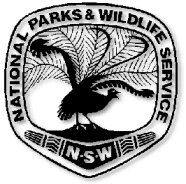 |
The Hacking River Catchment Management Committee and Royal National Park would like to hear from you if you are interested in voluntarily helping with the reconstruction and rehabilitation of the Coast Walk. The main activities where we need your assistance are in general soil erosion control, revegetation, local native plant transplantation and propogation and general assistance in any sort of work. All volunteers would receive training and would be covered for Worker's Compensation while working under the supervision of a NPWS officer. Your assistance, whether on a half-day basis on a weekend or a more full-time basis would be most appreciated.
Please contact the Royal National Park's volunteers coordinator on 9542 0666 or write to NPWS South Metropolitan District, RNP, Audley, PO Box 44, SUTHERLAND NSW 2232. Red Tide at Jibbon
Late in February, users of Jibbon Beach in the Royal National Park, east of Bundeena, were concerned to find themselves swimming in red water! A sample of the "red water" was sent to the EPA with a request for an explanation of the strange phenomenon. To date, there has been no satisfactory answer as to the cause of the red tide. There are some suggestions that the cause was an algael bloom following the release of ballast water at the head of Port Hacking.
PHPS has had a long-standing concern with the dangers of indiscriminant release of ballast water on the waterway. The Association has noted that since 1989 the Australian Quarantine and Inspection Sevice has been involved in the Ballast water issue following indications that the discharge into harbours of ballast water from overseas shipping had introduced exotic organisms. Progress, however, has been painfully slow. A major symposium was finally held in May 1994 and the subsequently the Interim Ballast Water Management Advisor Council was established. Priorities for research have been established as well as trials for methods of treating ballast water before release. It's rather frightening to know that these initiatives are among the leading ones globally! Environmental Damage Caused by Building Sites
Councils require plans for sediment controls to be used with each building site. It is evident that many builders do not maintain sediment controls in working order. Council officers will soon be authorised to hand out fines of $600 under the Clean Waters Act, with much higher fines for non-compliance.
Mr Peter Wells, Hacking River Catchment Management Committee Chairman, said that "if a storm struck today, most building sites in Sutherland Shire and Helensburgh area would lose a great deal of sediment. although each site may not contribute much sediment, together they can be a terrible load on the Port Hacking waterways. Builders who don't do the right thing with bare soil on their sites leave themselves open to be fined. The community should not have to put up with this environmental degradation".
Erosion from building sites results in deposits of sediment and shallowing water at the heads of bays. This is occurring at the head of Yowie Bay, Burraneer Bay, North West Arm and the upper reaches of the Hacking River itself. Sedimentation restricts navigation, reduces water clarity and may smother seagrass beds leading to depletion of stocks of fish and invertebrates.
The HRCMC in the next issue of the Protectorate (issue No. 9) will provide more details about the problems of sedimentation caused by urban erosion. Spark Plug or New Engine?
Max Kelly
Latest word is that the long-awaited EIS for the Bundeena-Maianbar sewage system options will not be released until at least mid year. Throughout this whole process - extending now into years - no one has sought fit to examine just what is the existing situation in regard to septics, aerated systems (Envirocycles, etc.) and pump outs. Everyone says that existing systems (especially old septics) are a major cause of Port pollution. Yet when have these systems been examined? By whom? When?
PHPS has endeavoured to find out. Initially the response was disappointing in the extreme. Sutherland Council, the Water Board (now Sydney Water), and the Environment Protection Agency (EPA) gave conflicting responses as to who was exactly responsible for ensuring standards were being met. The council said "not our problem". The EPA said that local councils were the surveying authority. Yes, said the EPA, at a domestic level it was the concern of Sutherland Shire Council. The Council seemed greatly surprised. More importantly it appears that there has not, at least within the last twenty years, been any sort of audit of the 920 on-site absorption septic tank systems in Bundeena and Maianbar. Nor did the Council have records of the number of such systems in the Grays Point/Loftus areas.
Sutherland Shire Council has moved to rectify this situation. (see accompanying item )
The issue of the effectiveness or otherwise of septic tank systems becomes all the more important when new systems of sewage disposal are being considered, costing many millions of dollars. Is it not reasonable to ask: Why install a mighty and costly new engine when all that is needed is a new spark plug or two?
It is interesting to note the actions of Wollongong Council with regard to their monitoring of septic systems. It has recently inspected every property at Stanwell Park and Stanwell Tops, interviewed all residents and provided information on septic maintenance. As a result of these inspections Council served many notices requiring upgrading. Contrary to popular belief, the Council found the majority of problems related to pump-out systems. Defects here were numerous and included:
-
Direct connections to stormwater drainage lines
-
A pump permanently mounted onto a holding well and connected to the street gutter
-
Inadequate frequency of effluent removal
-
Siphonage of overfull tanks with a garden hose to the street gutter, and
-
The breaking of a hole in the bottom of holding tanks.
All of these actions have, of course, dire consequences for the health of the locality and, ultimately, for the entire catchment.
Bundeena/Maianbar Septic Systems
Sutherland Shire Council
Council, in conjunction with the Hacking River Catchment Management Committee has commenced a detailed examination of Bundeena/Maianbar Septic systems with a view to minimising unacceptable management practices. A Council officer has addressed the HRCMC outlining the nature and extent of the septic systems in the village. The difficulties experienced with some of the shallow topsoil areas was also related with an overview provided of recorded discharge problem areas.
Further stages of this important exercise will centre on the planning and implementation of a community information exercise which may be run by Council officers door knocking in the village.
This exercise will be a parallel with initiatives undertaken by the Hacking River Catchment Management Committee to encourage sound and proper management of septic systems.
Maianbar Concern
Brian Page
Because of terrain structure (rock base and shallow sand clay soil) also old or badly constructed septics, the seepage from septics in parts of Maianbar, finds its way to the Western corner of Fisherman's Bay via the Sydney Water easement.
This situation in all likelihood raises the level of sewage bacteria in the Bay to unacceptable levels, posing a health threat to swimmers. With the lack of dredging at the mouth of the Bay, the waterway is not flushed out. At low tide, residents can smell the septic pollution.
With no definite statement on implementation of sewerage work, people are loath to spend money on costly up-grading of existing septics.
Maybe Sydney Water, Sutherland Shire Council, or some responsible Authority, could do something of a temporary nature by using a series of ponds down the Sydney Water easement to at least reduce the polluting source. PHPS Annual General Meeting
The PHPS AGM for 1995 was held on Sunday 26 February on a beautiful sunny day in the dappled shade of the wonderful Sydney angophoras of Bundeena Park. The President, George Harrison began procedures by welcoming all present and reviewing Minutes of the AGM held in 1994. The President then tabled his report, an abridged version of which is included below.
After the Treasurer gave his report, Office Bearers for 1995 were elected. Election of Office Bearers followed the Treasurer's report with the following people elected:
Paul Martin (President), Max Kelly (Vice President), Victor Leuliette (Treasurer), George Harrison (Secretary), Belinda Allen, Bryan Page, Miriam Verbeek (Comittee members).
Please note that Committee Meetings of PHPS, held at 8.30 am on the first Saturday of each month at the Bundeena Community Centre are open to all interested members and friends. In 1993 and 1994, each second meeting was held at Miranda in response to requests from members living on the north side of Port Hacking to provide a venue more accessible to them. Apart from the first of the eight subsequent meetings that were held at Miranda, no member attended who was not directly involved on the committee. Since no one from the Northern side of Port Hacking nominated to join the committee of PHPS, it has been decided to hold all future meetings in Bundeena. However, this position is to be kept under review. Those interested in attending committee meetings and becoming more actively involved should contact the Secretary (on 523 8436) to discuss the venue preferences. President's Report
Welcome to the 1994 AGM of PHPS. You will remember that our last AGM was held in the immediate aftermath of the 1994 bushfires and their dramatic impact on substantial areas of the Hacking River Catchment. In the last year, your committee has been concerned with the impact of a number of ongoing issues and proposed development of the amenity of the Hacking and its catchment and I'd like to mention each of these in turn:
Helensburgh: You will find a potted history of the decades long fight against urban development proposals in the latest issue (issue number 7) of the Protectorate. PHPS in 1994 wrote to Minister Webster opposing the Commission of Inquiry he had instigated and also issued a press release highlighting our opposition to that Commission. Nevertheless PHPS made both submissions and personal representation to the Inquiry. The outcome of that Inquiry is presented in summary in this issue of the Protectorate (issue number 8).
Sewage and Ocean Outfall: Ocean beaches in Sutherland Shire are now recognised as the most polluted in Sydney. Sydney Water's extensive survey of pollution in Bate Bay points the finger directly at the Potter Point Ocean outfall and not at septic overflows/leakages in Bundeena and Maianbar as some would have us believe. Both parties in the coming State election have promised to upgrade the Cronulla STP. But in 1995, the practice of discharging effluent into the ocean must be seriously questioned. PHPS determined at its December meeting to oppose any increase in amounts of effluent being pumped into the ocean. This is hardly a radical position, shared as it is by the EPA and people such as Ian (Clean up Australia) Kiernan . However, it may lead the PHPS opposing aspects of the EIS for sewering Bundeena and Maianbar should its preferred option be to pump sewage to the outfall.
Dredging: Despite the fine consensus work done by PHPS and other community members which resulted in the memorandum on Navigation, no action has taken place on dredging because of a dispute over funding between the State Government and Local Council. We wrote to Minister Armstrong and local MP Malcolm Kerr stating that we regarded dredging a State Government responsibility. We also note that Bob Carr has given a written undertaking to fund dredging should the ALP win Government at the forthcoming election. PHPS will continue to press for the implementation of the Memorandum.
Boat Ramp: Two years have passed since the issue of providing a boat ramp for Bundeena and Maianbar arose in earnest. The NPWS has now commissioned Fathom Consulting to do an EIS on the construction of a more permanent facility. In the last twelve months, PHPS has participated in two round table discussions and a site inspection. PHPS also made a submission to the consultants outlining our concerns. Four sites were considered, one at the ferry wharf at Bundeena, two in Simpson's Bay and finally the current location at Bonnie Vale. The first three have been rejected on various grounds. Fathom Consulting propose some sort of low impact crossing on the current site - concrete sleepers connected by chains. Various locations for parking vehicles were discussed during the site inspection. The whole process would be subject to annual review.
PHPS has been aware of local sensitivities throughout the process and has, I think, taken a principled position: we have not rejected the concept outright, but have insisted on an EIS on which we reserve the right to comment. The National Parks Association which takes a different principled position against any further development within the national park has been critical of PHPS for not taking a harder line. At the same time the "Water Access" group in Bundeena and Maianbar, or elements therein have accused PHPS of being "bloody minded greenies". So we are in the happy position of copping it from both sides. PHPS can, I think, take credit for the existence of this EIS process, and we will await its release with interest.
Jet Skis: PHPS has long taken a stand against anti-social behaviour by personal water craft riders. 1994 saw the Waterways Authority finally beginning to implement more stringent controls on personal water craft users. PHPS, however, continues to agitate for the elimination of these craft from use in inappropriate areas such as the amphitheatre-like venue of Port Hacking.
Protectorate: PHPS has applied successfully to the Hacking River Total Catchment Committee for a grant of $4850 to produce three to four issues of the Protectorate in the coming year. We intend to ask for all groups and authorities with an interest in the Port to contribute articles for the publication in an ongoing way. In the past, we have self-funded the Protectorate through advertising and a great deal of generous donation of labour, our maximum output of the Portectorate was a high-quality issue a year. In 1994 we did not manage a single issue for a variety of reasons.
In sum: The coming twelve months promises to be busy and eventful. We have a State Election in March, Council elections in September and still the possibility of a Federal poll. We have the EIS due on the boat ramp, the Bundeena and Maianbar Sewage EIS, a Sutherland Shire heritage study of the Waterway pending. Inappropriate development in Helensburgh continues to be a threat to the catchment until the area receives complete environment protection. These and the continual problems of 'casual pollution' and degradation in the catchment will keep PHPS occupied throughout 1994. The message is that there is plenty to do and constant vigilance is required to maintain Port Hacking and its catchment in a condition that can be enjoyed by generations to come.
PHPS Submission to Sydney Water
Subsequent to the Managing Wastewater workshop (p.5), PHPS wrote to Sydney Water regarding the community consultation process. The PHPS submission was included with the Minutes circulated to all participants at the workshop. The substance of the submission is reprinted below:
The information that has been the basis of deliberation deals substantially with the capital equipment and the capital economics of the Cronulla STP proposal. Sewage considerations are, aftera ll, only an element in water cycle management. However, sewage capital structure choices are pre-determinants of the likelihood of other impacts such as rainwater use and runoff management, impacts on groundwater, and related development impacts. If the system is tailored to inefficient water usage, or to poor 'at source' management, it will facilitate the continuation of these inefficient practices. The control and regulation frameworks, including pricing, are fundamental to determining the actual impact on the water cycle of any development, including this Cronulla STP.
We are dealing with a system [the water cycle] with a number of elements. We know that any solutions to the longer term problems will require addressing all these elements in an integrated manner. But the Cronulla STP proposal treats the capital works aspect, coupled with the water treatment aspect, as stand alone.
A further problem with the proposal currently as presented is that aggregated capital expenditure considerations bear little relationship to the impact that the individual or the household will feel as reflected in rates and water pricing. Information is required on:
- the penalty pricing for 'at-source' polluting
- the price advantage in the use of recycled water
- the pricing of 'virgin' water
|
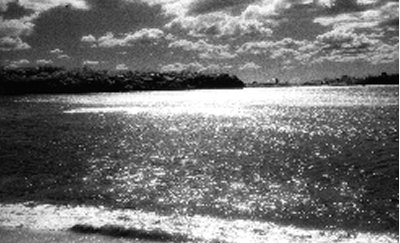 |
It is also necessary to have information about choices for households to opt in or out of the system. What are cost ramifications for households who decide to collect rainwater for their own use or opt out of sewage connection where alternatives such as effective on-site treatment are available (assuming that these can be demonstrable and of equivalent effectiveness)?
We all know that water pricing and controls are going to have an impact, and that they are going to change substantially. It is unhelpful to the community decision-making process to treat these as factors that cannot be predicted. If Sydney Water cannot state their pricing indication, or cannot identify the likely regulatory regimes, then it is a gross abuse to expect the community to guess what these might be. Surely the community should at least be able to get the carefully researched and verified views of the experts on how the various STP options are going to impact on them?
A suggested framework for considering the alternatives would be to clearly establish the water cycle management plan for the catchment of the STP. This would include a clear consideration of the sources and uses, management and required service standards projected over a reasonable period. It would inevitably require consideration of local government issues as well as water supply. This would allow the definition of wastewater standards, likely demands and so forth, within the context of the other issues. Water pricing structures would have to be clarified by Sydney Water. These elements would then allow the water cycle issues and the impact on users of the alternatives to be outlined, permitting a more meaningful consideration of these alternatives. Helensbourgh Commission of Inquiry
In the past two issues of the Port Hacking Protectorate, we have reported in detail on the ongoing debate over urban development proposals for the township of Helensburgh. In 1994, this debate came to a head when the Minister for Planning and Minister for Housing, Mr Robert Webster, appointed a Commission of Inquiry into Appropriate Landuse and Zonings within the Vicinity of Helensburgh.
In December 1994, the Commissioner reported on the matter. Below are extracts of the executive summary from that report. The significant recommendation from that report is that:
"there be no change in the current Local Environment Plan or current zonings until further studies are undertaken primarily aimed at identifying existing and potential impacts from various landuse, then setting of appropriate environmental objectives, followed by identification of a cost-effective strategic catchment management plan to control existing catchment pollution sources and identify landuse controls capable of meeting these objectives."
The Inquiry was announced in April 1994 to deal with a complex set of issues and concern regarding urban development proposals for Helensburgh. Approximately 700 submissions were made to the Inquiry by 244 parties and around 7,000 submissions were also considered. In total over 25,000 pages of documents and over 50 consultant reports have been considered during the Inquiry. Nearly five weeks of public hearing, including three days of site inspections and three Round Table Sessions were undertaken between 5th July and 15th November 1994.
A number of studies specifically relating to the subject lands or issues have been conducted for or by Wollongong Council. Specific reference is made to the 1990 Draft Helensburgh Plan. The Plan includes detailed and thorough assessment of many previous studies and issues also raised at the Inquiry.
The issues assessment, and the findings and recommendations of Council's Draft Helensburgh Plan are largely consistent with the issues assessment and findings and recommendations of this Inquiry. The overrriding Terms of Reference of the Inquiry was:
"
To assess the capability of land in the general vicinity of Helensburgh, as identified on the attached map, to sustain various landuse options without causing significant environmental degradation."
The Inquiry found that basically previously disturbed and cleared areas of Gills Creek areas and a smaller cleared and filled area of Lady Carrington Estate have potential for urban capability, but further studies are required to more accurately define such areas as well as to define the necessary controls, limited (to development), or other requirements. |
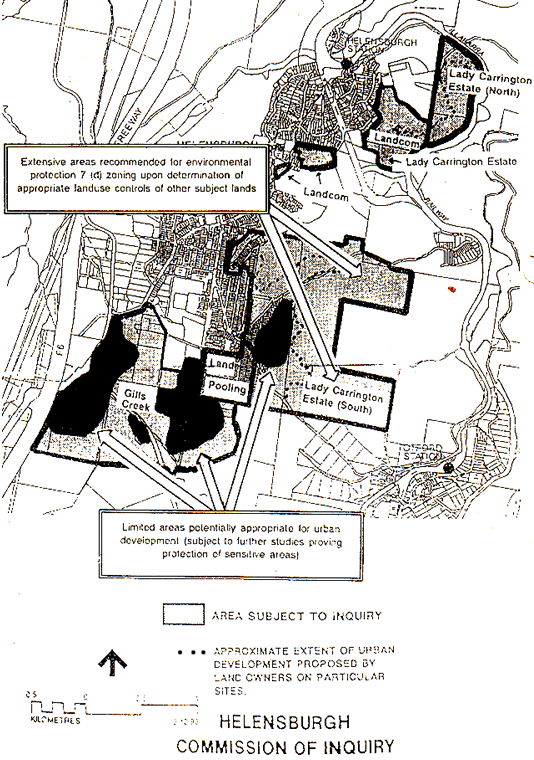 |
As to other subject lands, the concurrent studies as to catchment management standards, fauna habitat studies and potential impacts, success of otherwise of water quality control pond trials, the possible rezoning and development of selected area/s of Gills Creek and cleared areas of Lady Carrington Estate (south) lands, all preceded consideration of Land Pooling land, Landcom land (the tip site) or Lady Carrington Estate land (also near the tip, the northern site). These latter subject lands have limited potential urban capability, but equally there is concern and uncertainty as to water quality, downstream impacts, flora, and fauna potential impacts and other matters. In total, there are greater potential impacts from urban development proposals or rezoning these other subjects lands than for the Gills Creek and Lady Carrington Estate (south) cleared and disturbed areas identified as having potential urban capability.
As to the other terms of reference:
To make recommendations on appropriate landuses and zoning based on the assessment of capability taking into account:
-
Water quality impacts on the Hacking River and whether or not urban development provides opportunities to improve water quality.
Existing urban and rural landuse and zonings are impacting the Hacking River to an unacceptable degree, based on the limited studies undertaken. The extent of impact and necessary controls requires further assessment on a catchment wide basis. Standards, objectives and other matters would then follow from such assessment (including landuse controls).
Council, the NPWS, the EPA and a number of other parties agree that protection of the sensitive National park and Hacking River is of paramount importance; that experimentation or risks should not be allowed for such an important and sensitive area. A catchment based approach is suggested by the EPA in that a recommended strategy is required (including urban development) in view of setting appropriate environmental objectives (including water quality). This is supported by involved Government Departments, and the Hacking River Catchment Management Committee. This includes further study and assessment of existing pollution sources and impacts, development of a strategy and standards and then consideration of landuse and controls to meet these aims.
-
Potential environmental impacts from alternative landuses on the Royal National Park;
There are potential environmental impacts from alternative landuses (mainly being urban or rural landuse) on the Royal National Park which include, loss of fauna habitat, a reduced wildlife corridor (and arguably reduced wildlife use or increased predation), increased domestic animal predation into the National Park, increased weed invasion, and increased nutrient/algal problems in National Park waters.
Further studies are required before an assessment of potential impacts can be made. Such further studies include the:
- wildlife corridor potential impacts as to habitat loss,
- existing ridge fauna habitat and potential impact of its loss or partial clearing,
- impacts to rare and endangered species, particularly the Sooty Owl,
- sources and control of other impacts.
-
The conservation value of the land including flora, fauna and places of Aboriginal and early European heritage;
A significant number of rare and endangered flora or flora communities of conservation significance are located on subject land, but are generally not in areas proposed for urban development (further study is required for Lady Carrington Estate (south) as to two significant species which may regenerate following recent fires).
There is a difference of professional opinion as to conservation value of ridge vegetation on the Lady Carrington Estate (south) land, and the likely impacts or potential changes that could result to its conservation value with development, (even with tree retention strategies) and to what cumulative or long term effects may result to fauna, fauna habitat and fauna or conservation significance. The risk or threat to a number of rare and endangered fauna, such as the Sooty Owl, indicates that considerable care is required. Accordingly, there is insufficient information to make conclusive recommendations on the value of the ridge top fauna habitat and fauna value, and further detailed studies are required to assess this. Given the sensitivity of the area, a Fauna Impact Statement, including consideration of rare and endangered species recovery plan/s may be appropriate.
While a number of archaeological and heritage items occur in the Helensburgh area, none are located on the lands under investigation for urban expansion. The only currently identified archaeological constraint to development within the study area is site 9, which is located within an area which would be inundated if a major stormwater control structure for Gills Creek Catchment was constructed. The subject proposed water control structure can be relocated to avoid such impact and further study is considered appropriate with any development application.
- economic costs and benefits of alternative landuse, including the financial costs to Wollongong City Council and the State government with respect to the provisions and maintenance of public utilities and community services relating to:
-
the lands specified on the attached map;
In summary, on the basis of user pays which is now widespread in both State and Local government, there are limited costs to State and Local Government. However with urban development proposal, there are a number of likely additional costs to State Government and possibly to Local Government where infrastructure (such as electricity or community services) do not recover full costs. These costs are relatively small based on the evidence to the Inquiry. There are equally a number of benefits with urban development, mostly to the local Helensburgh community, as well as to Council in that certain infrastructure, community facilities, and, not the least, the potential to clean up and control certain urban runoff. Council's Draft Plan (Environmental Study-Strategy) came to this conclusion after detailed assessment and liaison with government agencies (including 30 service providers), consultants and the community (involving at least one survey)
Relevant sections of council's Draft Helensburgh Plan should be updated, to assist in determination of Section 94 developer contributions, for both any development of the subjects areas as well as development of urban infill areas with existing Helensburgh (after other studies and assessment).
-
Helensburgh urban area:
There is limited information submitted on cost and benefits for existing Helensburgh. Any significant development in Helensburgh requires additional infrastructure. This includes re-zoning of subject areas to urban or council's proposed 40% increase in existing Helensburgh by urban consolidation. In particular, water and sewerage infrastructure will require upgrading.
The major trade-offs proposed by lady Carrington Estate include, dedication of substantial lands to the National Parks and Wildlife Service at no cost (considered by NPWS as invaluable), options involving land and/or construction of stormwater controls serving existing Helensburgh and offers to cease polluting activities on lands outside the terms of reference (e.g. Otford Valley Farm).
Subject to the further studies and assessments required, and subject to urban capability being found for Lady Carrington Estate land, it would appear that negotiations could be explored similar to and concurrent with other arrangements or negotiations for infrastructure provision, staging, etc.
-
The role of Helensburgh in providing housing and employment opportunities for Southern Sydney and the Illawarra;
Overall it appears that Helensburgh's role in providing employment is currently fairly small, and would increase to some extent if some development was permitted. However, with the current high use of the car, Helensburgh would be likely to remain more of a dormitory town, that is, the situation where most residents commute to either Wollongong or Sydney for employment and some business or shopping trips, would be expected to continue. Industrial zonings within the Gills Creek subject lands has the greatest potential for longer term local employment. However, the Gills Creek landowners proposal is unclear as to industrial landuse and appears to favour greater residential landuse.
-
The implications for the character of Helensburgh;
Submissions to the Inquiry span the range of community feeling, from "increasing development enables better shops, facilities and infrastructure", to "increasing development means greater traffic, bushland loss or pollution". Similar development has occurred and is proposed with infill development of existing Helensburgh (40% increase in population) and arguably the resulting impact is not and has not been substantial though with further development the Village atmosphere would be lost to some degree.
-
Bushfire risk
Rezoning of all subject lands to Environmental Protection would not allow urban development to further approach bushland areas (noting that considerable areas of Gills Creek and a lesser area of Lady Carrington Estate are already cleared). Conservation groups argue that revegetation of these areas is possible. In this respect, certain controlled development would reduce fire hazard or exposure of some older areas of Helenburgh which have little or no buffers to bushland, have no peripheral fire tracks or escape routes and have other risk problems such as slope, vegetation or construction material problems according to the Department of Bushfire Services.
(copies of the report may be purchased from the Office of the Commissioners of Inquiry for Environment and Planning, GPO Box 3451, NSW 2001, ph 299 2904. Postage charges apply at $6.00 for the first report, and $3.00 for additional copies.)
Bag Limits for Shellfish |

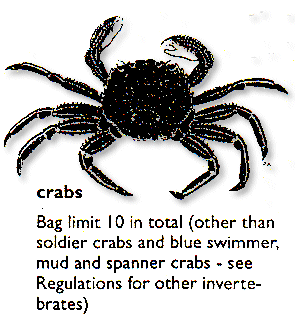
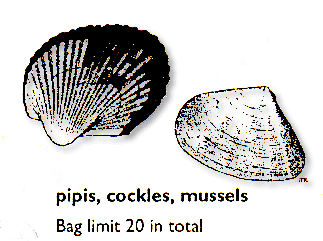

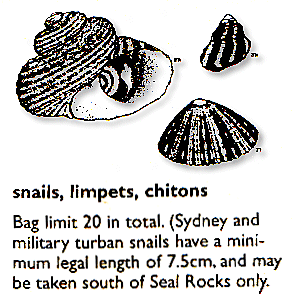
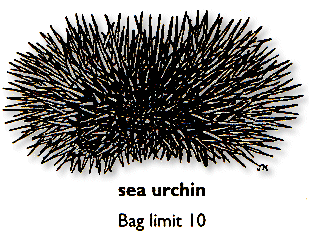


 |
* Bag limits do not apply to IPAs (Intertidal Protection Areas) as you are prohibited from collecting intertidal invertebrates in these areas
Jetskis - What's Happening?
These directions to PWC Riders were implemented at the end of 1994. We hope to be bringing you a report of how well they're working as an instrument to reduce the nuisance of PWCs in the next issue of the Protectorate. |
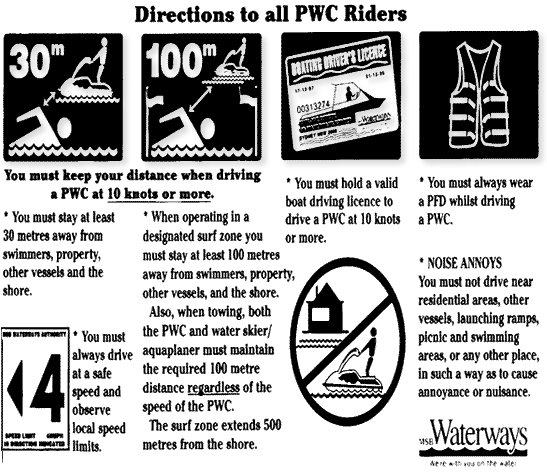 |
| top of page |
|
